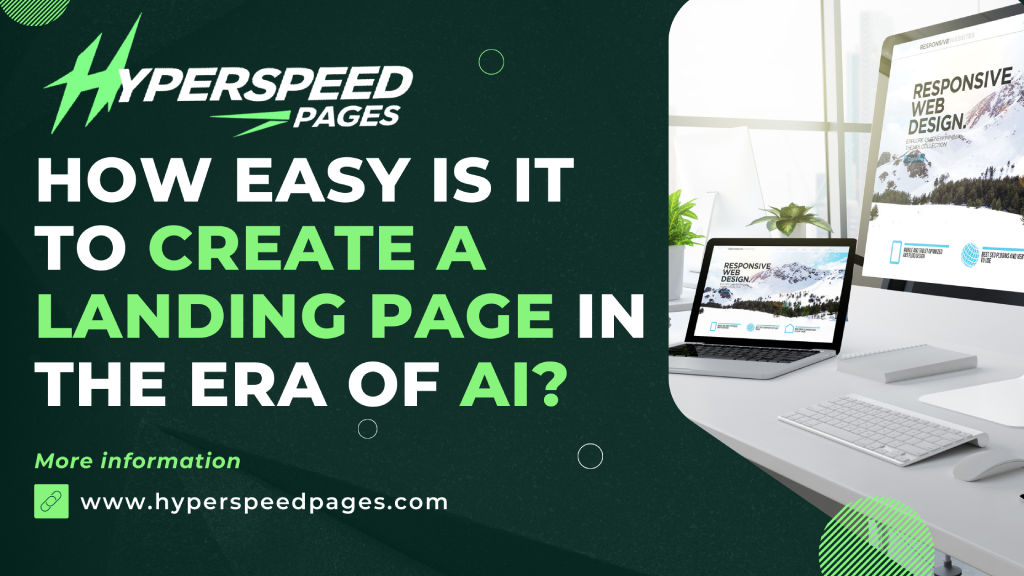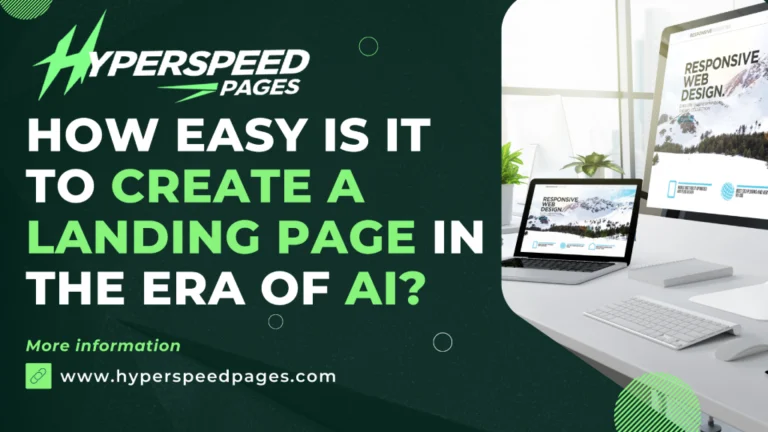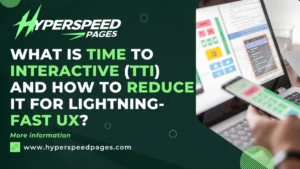
Landing pages—standalone web pages designed to convert visitors into leads or customers—are critical components of marketing campaigns. With AI’s ability to analyze data, automate processes, and enhance creativity, it’s revolutionizing how landing pages are designed and developed.
Why AI is a Game-Changer for Landing Pages
Landing pages must be visually appealing, user-friendly, and optimized for conversions. Traditional methods of designing and testing landing pages can be time-consuming and resource-intensive. AI streamlines this process by:
- Automating design decisions
- Enhancing personalization
- Improving conversion rates with predictive analytics
- Optimizing content in real-time
1. AI-Powered Design Tools
AI-driven design platforms are transforming how landing pages are visually conceptualized and built. These tools leverage machine learning (ML) and generative AI to automate and enhance the creative process.
- Generative Design: Tools like DALL·E, Midjourney, and Canva’s AI features allow designers to generate custom images, icons, and layouts tailored to a landing page’s theme. By inputting simple text prompts (e.g., “modern tech landing page background”), these platforms create visually appealing assets in seconds, reducing the need for manual graphic design work.
- Layout Optimization: AI platforms like Figma’s AI plugins and Adobe Sensei analyze design trends and user preferences to suggest layouts that maximize engagement. For instance, they can recommend placing the CTA button above the fold or adjusting image sizes for optimal visual hierarchy.
- Color and Typography Suggestions: AI tools analyze brand guidelines and audience demographics to recommend color schemes and fonts that resonate with target users. This ensures the landing page aligns with branding while appealing to its intended audience.
- Impact: Designers save hours of manual work, while businesses benefit from aesthetically pleasing, conversion-focused landing pages built on data-driven insights.
2. Natural Language Processing (NLP) for Copywriting
Compelling copy is the backbone of any successful landing page. AI-powered NLP technologies are stepping in to craft persuasive, SEO-optimized content that speaks directly to visitors.
- AI Copywriting Tools: Platforms like Jasper, Copy.ai, and Writesonic use NLP to generate headlines, subheadings, and body copy based on keywords, tone, and audience intent. For example, inputting “increase SaaS sign-ups” could yield a punchy headline like “Boost Your SaaS Growth with One Click.”
- Tone and Sentiment Analysis: NLP algorithms analyze existing content to ensure the tone aligns with the brand (e.g., professional, friendly, urgent) and evokes the desired emotional response from visitors.
- Multilingual Content: Tools like DeepL and Google Translate’s AI enhancements enable businesses to create landing pages in multiple languages, broadening their reach without sacrificing quality.
- Impact: AI reduces the time spent on copywriting while ensuring the messaging is clear, persuasive, and tailored to specific audience segments.
3. Personalization with Machine Learning
One-size-fits-all landing pages are a thing of the past. Machine learning (ML), a subset of AI, enables hyper-personalized experiences that adapt to individual visitors in real time.
- Dynamic Content: ML algorithms analyze user data—such as browsing history, location, and demographics—to serve personalized content. For instance, a visitor from New York might see a landing page with local event details, while someone from London sees a different offer.
- Behavioral Targeting: Tools like HubSpot and Optimizely use ML to track user behavior (e.g., time spent on page, clicks) and adjust elements like CTAs or images to match preferences.
- Predictive Analytics: ML models predict which design or content variations are most likely to convert specific user segments, allowing developers to prioritize high-impact features.
- Impact: Personalized landing pages increase engagement and conversion rates by delivering relevant experiences to each visitor.
4. AI-Driven A/B Testing and Optimization
Optimization is key to mobile app landing page success, and AI takes A/B testing to the next level by automating and accelerating the process.
- Automated A/B Testing: Platforms like Google Optimize and VWO use AI to test multiple versions of a landing page (e.g., different headlines, button colors) and identify the best performer faster than traditional methods.
- Heatmap Analysis: AI tools like Hotjar and Crazy Egg generate heat maps showing where users click, scroll, or linger, helping developers refine layouts and eliminate friction points.
- Conversion Rate Optimization (CRO): AI systems analyze thousands of data points—such as bounce rates and form completions—to recommend changes that boost conversions.
- Impact: AI eliminates guesswork, allowing businesses to deploy landing pages that are continuously optimized for peak performance.
5. Chatbots and Conversational AI
Landing pages often include interactive elements like chatbots, powered by conversational AI, to guide visitors and capture leads.
- Lead Qualification: Chatbots like those built with Dialogflow or Drift engage visitors, answer questions, and qualify leads by asking targeted questions (e.g., “What’s your biggest marketing challenge?”).
- 24/7 Support: AI chatbots provide instant responses, reducing bounce rates and keeping visitors engaged even outside business hours.
- Personalized Recommendations: By integrating with CRM systems, chatbots suggest products or services based on visitor data, nudging them toward conversion.
- Impact: Conversational AI enhances UX, increases lead capture, and keeps visitors on the page longer.
6. AI in Development and Coding
AI isn’t just for design—it’s also transforming the technical side of landing page development.
- Low-Code/No-Code Platforms: Tools like Bubble and Webflow integrate AI to simplify coding. For example, Webflow’s AI suggests responsive design adjustments for mobile devices, ensuring cross-platform compatibility.
- Code Generation: AI systems like GitHub Copilot assist developers by auto-generating HTML, CSS, or JavaScript snippets for landing page elements, such as forms or animations.
- Performance Optimization: AI tools like Cloudflare’s AI optimize page load times by compressing images, caching content, and reducing server latency.
- Impact: Developers can build landing pages faster and with fewer errors, while ensuring they’re lightweight and SEO-friendly.
7. SEO Optimization with AI
A landing page is useless if it doesn’t rank on search engines. AI-powered SEO tools ensure visibility and relevance.
- Keyword Research: Tools like Ahrefs and SEMrush use AI to identify high-performing keywords (e.g., “AI landing page design”) and suggest related terms to target.
- On-Page SEO: AI platforms like SurferSEO analyze top-ranking pages and recommend optimizations for meta tags, headings, and content density.
- Voice Search Optimization: With the rise of voice assistants, AI tools adapt landing page content for natural language queries (e.g., “How does AI help with landing pages?”).
- Impact: AI-driven SEO boosts organic traffic, making landing pages more discoverable to potential customers.
8. AI-Powered User Intent Prediction
Understanding why a visitor lands on a page is critical. AI uses advanced algorithms to predict user intent and tailor the experience accordingly.
- Intent Classification: Tools like MonkeyLearn or IBM Watson analyze search queries, referral sources, and on-page behavior to classify intent (e.g., informational, transactional).
- Customized CTAs: Based on intent, AI adjusts CTAs—for example, offering a demo to a high-intent visitor or a free guide to someone seeking information.
- Exit-Intent Popups: AI detects when a user is about to leave (via mouse movement or scroll speed) and triggers personalized pop-ups to retain them.
- Impact: Predicting intent ensures landing pages meet user needs, improving retention and conversions.
9. AI for Accessibility Enhancements
Inclusive design is a priority in 2025, and AI helps ensure landing pages are accessible to all users.
- Alt Text Generation: AI tools like Microsoft Azure’s Computer Vision automatically generate descriptive alt text for images, aiding visually impaired users.
- Contrast Adjustment: AI analyzes color schemes and suggests adjustments to meet WCAG (Web Content Accessibility Guidelines) standards.
- Voice Navigation: AI-powered voice interfaces allow users to navigate landing pages hands-free, benefiting those with motor impairments.
- Impact: AI-driven accessibility broadens audience reach and ensures compliance with legal standards.
10. AI-Enhanced Video Content Creation
AI simplifies video production for landing pages.
- Automated Video Editing: RunwayML edits footage and adds captions.
- Personalized Videos: Synthesia creates custom videos with AI avatars.
- Thumbnail Optimization: AI boosts click-through rates with thumbnails.
- Impact: Engaging video content enhances appeal.
11. AI for Real-Time Analytics
AI delivers instant insights for agile refinement.
- Traffic Analysis: Google Analytics 4 tracks behavior in real time.
- Sentiment Tracking: AI gauges user satisfaction.
- Performance Dashboards: AI highlights actionable data.
- Impact: Real-time analytics enable rapid iteration.
12. AI-Powered Form Optimization
AI ensures forms are effective.
- Smart Forms: Typeform’s AI adapts questions dynamically.
- Abandonment Prevention: AI triggers incentives for completion.
- Data Validation: AI checks input accuracy.
- Impact: Optimized forms increase lead quality.
13. AI for Cross-Channel Integration
AI connects landing pages to marketing ecosystems.
- Ad Syncing: AdRoll aligns content with ads.
- Email Follow-Ups: Mailchimp triggers personalized emails.
- Social Proof: AI curates real-time testimonials.
- Impact: Integration boosts cohesion and trust.
14. AI-Driven Security Features
AI strengthens landing page security.
- Fraud Detection: Sift identifies bots.
- SSL Optimization: AI updates secure connections.
- Data Encryption: AI protects user inputs.
- Impact: Secure pages build trust.
15. AI for Gamification
AI scales gamification for engagement.
- Interactive Elements: Gamify creates quizzes or wheels.
- Reward Prediction: AI determines motivating rewards.
- Engagement Scoring: AI refines gamified features.
- Impact: Gamification increases time on page and conversions.
Real-World Examples of AI in Landing Page Creation
- Unbounce: This healthcare landing page builder uses AI to predict conversion potential and suggest design improvements, helping marketers create pages that convert up to 30% better.
- Instapage: With its AI-powered ad-to-page personalization, Instapage matches landing page content to PPC ad campaigns, ensuring a seamless user journey.
- Salesforce: The CRM giant uses AI to dynamically adjust landing page content for B2B clients, increasing lead generation by tailoring offers to specific industries.
Benefits of AI in Landing Page Design and Development
- Speed: AI automates repetitive tasks, cutting development time from weeks to days.
- Cost-Effectiveness: Reduced reliance on large design and dev teams lowers costs.
- Scalability: AI enables businesses to create and test multiple landing pages simultaneously.
- Higher Conversions: Data-driven insights and personalization lead to better user experiences and more conversions.
Challenges and Considerations
While AI offers immense potential, it’s not without challenges:
- Over-Reliance: Blindly trusting AI suggestions without human oversight can lead to generic or off-brand results.
- Data Privacy: Personalization requires user data, raising concerns about compliance with regulations like GDPR.
- Learning Curve: Teams may need training to fully leverage AI tools.
The Future of AI in Landing Page Creation
As AI continues to evolve, its role in landing page design and development will only grow. Expect advancements like:
- Emotion Recognition: AI analyzing facial expressions via webcams to adjust content based on user mood.
- Augmented Reality (AR) Integration: AI-powered AR landing pages offering interactive product previews.
- Self-Optimizing Pages: Landing pages that autonomously tweak themselves based on real-time performance data.
AI is no longer a futuristic concept—it’s actively shaping how landing pages are designed and developed in 2025.




